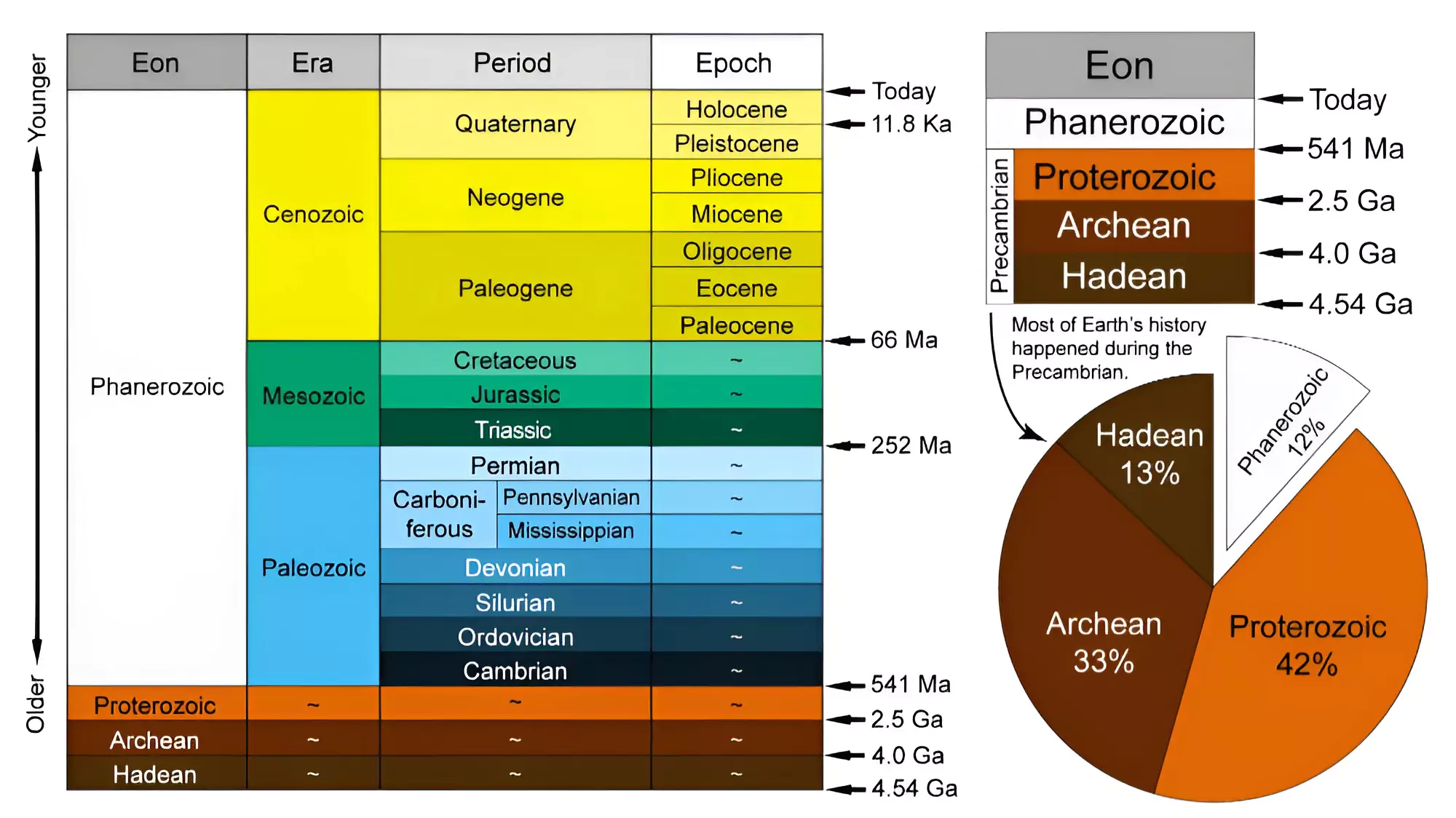Context:
A committee of 18 scientists have voted down a proposal to declare the start of the Anthropocene or Human Epoch in a geologic time scale.
Geologic Time Scale (GTS)
- It is designed by scientists to measure the history of the planet Earth.
- The GTS is divided, in descending order of duration, into aeons, eras, periods, epochs, and ages since the formation of Earth
- It is based on chronostratigraphic classification: It is an aspect of stratigraphy that deals with the relation between rock strata and the measurement of geological time.
- Stratigraphy is a branch of geology that deals with the study of rock layers (or strata).
- Characteristics of Chronostratigraphic units:
- They are not uniform and any two aeons, eras, periods, epochs, and ages do not encompass the same length of time.
- Marked by events: Transition from one to another is marked by events that shape the planet and its living conditions.
- Criteria: Each interval of Earth time must have a clear objective and a universally applicable starting point.
|
About Anthropocene
- The term Anthropocene was first coined in the year 2000 by the Dutch meteorologist Paul Crutzen and American botanist Eugene Stoermer.
- Present Geological Time Scale: Currently we are living in the Phanerozoic aeon, during the Cenozoic era, in the Quaternary period, the Holocene epoch, and the Meghalayan age.
-
Anthropocene Epoch:

-
- It emerged with the belief that the human activities have changed the Earth to such an extent that a new geological epoch has begun.
- The Anthropocene Working Group (AWG): It is a 37-member research group which began deliberations in 2009 to come up with a starting point for the epoch
- Period of Great Acceleration: The year 1952 after World War II was decided as the beginning of the Anthropocene Epoch.
- The period after 1952 saw a skyrocketing human population, surge in the burning of fossil fuels, the fallout of nuclear tests, the use of nitrogen-based fertilizers became rampant, and plastics became ubiquitous.
The International Union of Geological Sciences (IUGS)
- Established: It was founded in 1961 and is one of the largest scientific organizations engaged in geological sciences.
- Members: It has 121 national members, representing over a million geoscientists with membership open to countries or defined regions.
- It encourages international co-operation and participation in the Earth sciences in relation to human welfare and is a member of the International Science Council (ISC).
- Function: IUGS promotes and encourages the study of geological problems, and supports and facilitates international and interdisciplinary cooperation in the Earth sciences.
- With special consideration given to international standards; geoscience education; geoscience information; environmental management and hazards.
The International Commission on Stratigraphy (ICS)
- It is the largest and oldest constituent scientific body in the International Union of Geological Sciences (IUGS).
- Objective: It is to define precisely global units (systems, series and stages) of the International Chronostratigraphic Chart which is the basis for the units (periods, epochs and age) of the International Geological Time Scale
- It sets the global standards for the fundamental scale for expressing the history of the Earth.
- Subcommission: The work of the Commission is divided between seventeen subcommissions, each responsible for a specific period of geological time.
|
- The AWG submitted its proposal to the International Union of Geological Sciences (IUGS) in 2023.
- Vote: The proposal was taken up for a vote by the Subcommission on Quaternary Stratigraphy (SQS), a constituent body of the International Commission on Stratigraphy (the largest scientific organisation within the IUGS)
- The SQS rejected the proposal with a vote of 12 to 4, with two abstentions
-
Reasons for the Rejection:
- Standards to define Epoch: Adding an Anthropocene epoch and terminating the Holocene was not supported by the standards used to define epochs according to chronostratigraphy with the limited definition of the Anthropocene epoch proposed by the AWG.
- Massive change required: The last boundary between the Holocene and the Pleistocene, the Earth was covered by ice to 1/3rd of its extent with Holocene period resulting in the shift from Ice Age to Civilisation Age
- The boundaries between epochs should represent truly massive geological change.
Holocene Epoch:
- Its name derives from the Greek “holos”, meaning ‘whole’, and “kainos”, meaning “new”
- It began some 11,700 years ago, at the end of the Last Glacial Period (LGP).
- Ice Age: Upto 25% of the Earth’s land surface was covered by glaciers, the mean sea level was up to 400 feet lower, and the average temperature fell to 8 degree Celsius.
- The Holocene Period: It saw the warming of the Earth, and an end of Ice Age resulted in the rise of sea level and proliferation of human beings.
- Basically all of humanity’s recorded history falls in this epoch.
|
-
- Permanency of proof: The Geological Time Scale is based on records in solid rocks and the AWG has chosen sediments like the ones in Crawford Lake, Ontario, Canada, as the physical site to show a definitive break between the Holocene and the Anthropocene period.
- Event rather than Epoch: The planet’s most significant happenings like the mass dinosaurs extinction or the rapid expansion of biodiversity that filled the sky with oxygen 2.1-2.4 billion years ago are deemed as events thus therefore Anthropocene should not be seen as a new epoch but rather as an event.
- Events, in the language of geology, are looser terms which do not appear on the official GTS, and thus need no committees to approve their start dates.
Also Read: Ergosphere: Making A Black Hole Work
News Source: the Indian Express

